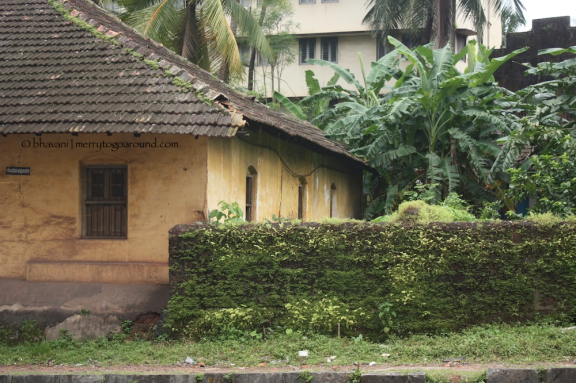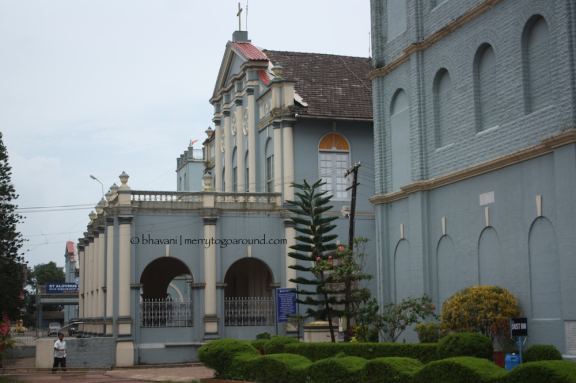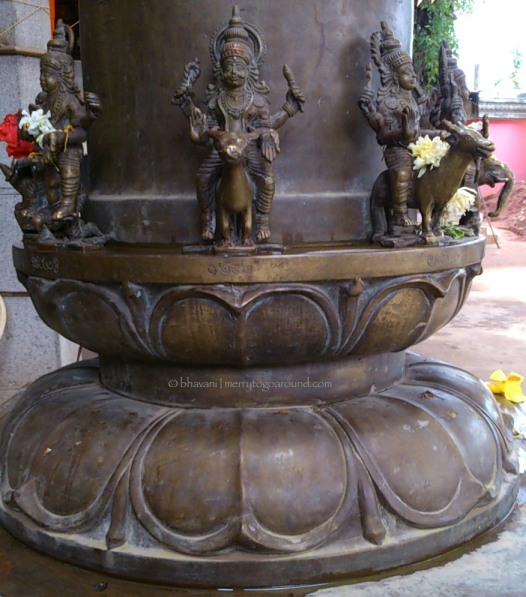The aircraft had to land on this narrow piece of land that led straight to a valley. And that valley was where an ill-fated aircraft had crashed a few months ago, it had just gone on and off the runaway! That is all I could think of during my entire descent into Mangalore. I held onto to the sides of the chair and hoped that I would I live… I’m not ready yet, I kept thinking…
It was a smooth landing and for once I was glad for that sharp, back-bending, bottles-tumbling-to-the-front-of-the-aircraft brake that was applied. I bent forward with the plane and kept waiting for it to NOT run off the runaway. Phew and I was still alive. Out of the airport, baggage in hand, caught a cab and headed out to the hotel I had pre-booked.

But I wasn’t ready for what was coming next.
Steep roads, swirling down the hill, it was like going down a softie icecream, do you get the picture? It had an almost ghat-like in structure. And then my first glimpse of the glimmering city. It looked beautiful laid out in front of me like a carpet of twinkling lights. I passed by a group of people standing behind a few bushes – it was a large family with adults and children. I wondered what they were doing so far from the city at 9.30 at night, and then I saw a flight approach. It made sense. With heads lifted and upturned faces, they watched the flight come closer and then land.
And that got me thinking about Mangalore. In my first thirty minutes of introduction, I had moved from extreme fear to delight to warm-fuzziness at seeing the group of adults and children watching a plane land. It had a small-town quality that always made me wish for more.
History of Mangalore was grand, Tipu Sultan had been here. It was a contested territories across dynasties. It had always been important in history. But what happened to it now? Was it just another mid-sized city in a large and vast country? I didn’t associate it with the grandeur of a big city or a city that had dynasties fighting for it. I associated Mangalore with crime and communal tensions, that was all I knew about it!
But surely Mangalore is much more than that and I was there to find out for myself.
The next morning, with just 4 hours before we made my way to Kasargode, the actual destination of the holiday, plans had to be made. Maps were scrutinised, the reception lady thoroughly grilled and Lonely Planet scanned carefully. The plan was done – the day would include Sultan Battery, the College Chapel, the Mangaladevi temple and a stop at Ideal Cafe since everyone was raving about it for food and coffee. And I can go to lengths for the promise of a good cup of coffee.
The driver of our car was not from Mangalore, frustrating to say the least. He had no clue where Sultan Battery was, tried asking local people who didn’t seem to be very clear either, aggravated by me not knowing how to pronounce the word ‘battery’ – like battery or bateri? Then Google Maps came to the rescue and showed us the way. On the way, Mangalore refused to let us get surly by tempting us with simple houses round every corner. My heart always melts at the sight of Mangalore tiles.

Sultan Battery is situated on a bend along a river as it snakes through to the sea. It seemed to have a very strategic position, overlooking both sides of the river in great distance. Built by Tipu Sultan, this was a watch-tower to see if anyone was entering the river and going inland, it definitely seemed like it would give a great view. Built with black basalt rocks, with viewing holes lining the entire wall, the structure seemed almost too simple in today’s complex understanding of war and defense. But then you put the lens of more than 200 years ago, and it seems like the location would have made this an extremely strategic watch-tower and that was all that mattered, the head start.
With every dynasty, there is destruction of property and places of worship of the now vanquished and destroyed foes. The rocks used to build this watchtower were supposed to have come from temples that were razed to the ground.




There were a few ships next to the river and we decided to go and take a look. It was a ship-building yard. It took them three months of day long hardwork to make just one ship and then she took off, to sail the seas and prove herself worthy. We watched Vajralaxmi enter the water for the first time and start to make her way to proving herself. There were some metal ships that looked gorgeous. Funnily these ships had an old look to them, even though they were all brand new… aren’t we all pampered by ships in movies where things looks gleaming and posh. These were fishing trawlers, they weren’t built to be gleaming and swanky.



We left Sultan Battery that was at one end of the city and started to make our way down into the city in search of the College Chapel. No one knew where it was, and even google seemed flummoxed this time. It took us around 20 minutes of roaming around an area of about one square kilometre till one person said you can maybe check on that hill. Important note to self: don’t call a chapel just a ‘chapel’, when its called ‘College Chapel’. The word ‘college’ was an important part that I left out in the hunt initially.
Pictures are not allowed here, but we got to go on a lovely personal tour by the person-in-charge. The entire place is painted, when I say entire I mean every inch! What looks like marble at first glance is not, it’s painted. What seems like a painting on a curtain and hanging on the wall, is all a painting… it’s made to look like it has been done on the curtain. The list gone on. The frescoes tell the story of Christ, and also the story of the patron saint. It’s a beautiful place and a definite must-do if you are in Mangalore.

It was time for lunch and stomachs were grumbling all around. And Ideal Cafe it was! The food was ok, nothing exceptional. It was definitely the coolest restaurant in Mangalore, everyone seemed to be there. The filter coffee that everyone praised was not that great. It had a rough, burnt taste of coffee that had some of the coffee powder at the base. They say that’s how Turkish coffee tastes, so there might be some who like it! (Disclaimer here: this is a novice’s comparison of coffee tastes!)
But if you are someone with a sweet tooth and can skip a meal then have ONLY ice-cream at Ideal Café. It was simply fabulous, the chocolate scoops topped with sauce and roasted nuts… bliss? (there is no picture, I was toooooo busy eating!)
The last stop in Mangalore was the Mangaladevi temple. This is the temple that Mangalore is named after, so it had to be seen.
A large temple, it was quiet and peaceful all the more as it was shut for the afternoon. We weren’t allowed inside as the Gods were sleeping and so we weren’t allowed to disturb them. I think these traditions are sweet, even if I am not a religious person. There is a story about all of it. and I like that. They feed around 3000 people every Friday and so everyone was busy in getting the temple ready for the next day. (we went on a Thursday)

Mangalore was sweet. A neat and clean city that still seems enveloped in the past and happily so, specially given the rapidly changing face of every city in the country. I wouldn’t say it surprised me, but it didn’t disappoint. It was small, roads were relatively peaceful and the streets were still lined with houses glowing in old-world charm. And like I said earlier, sloped roofs with Mangalore tiles… that’s all I need to be charmed… If they could add some nice coffee to the mix, it would make my day!
Well written !!
LikeLike
thanks 🙂
LikeLike
“Going down a softie ice cream” Only you could come up with that!!! Makes perfect sense too
LikeLike
hahahaha! 🙂 thanks!
LikeLike